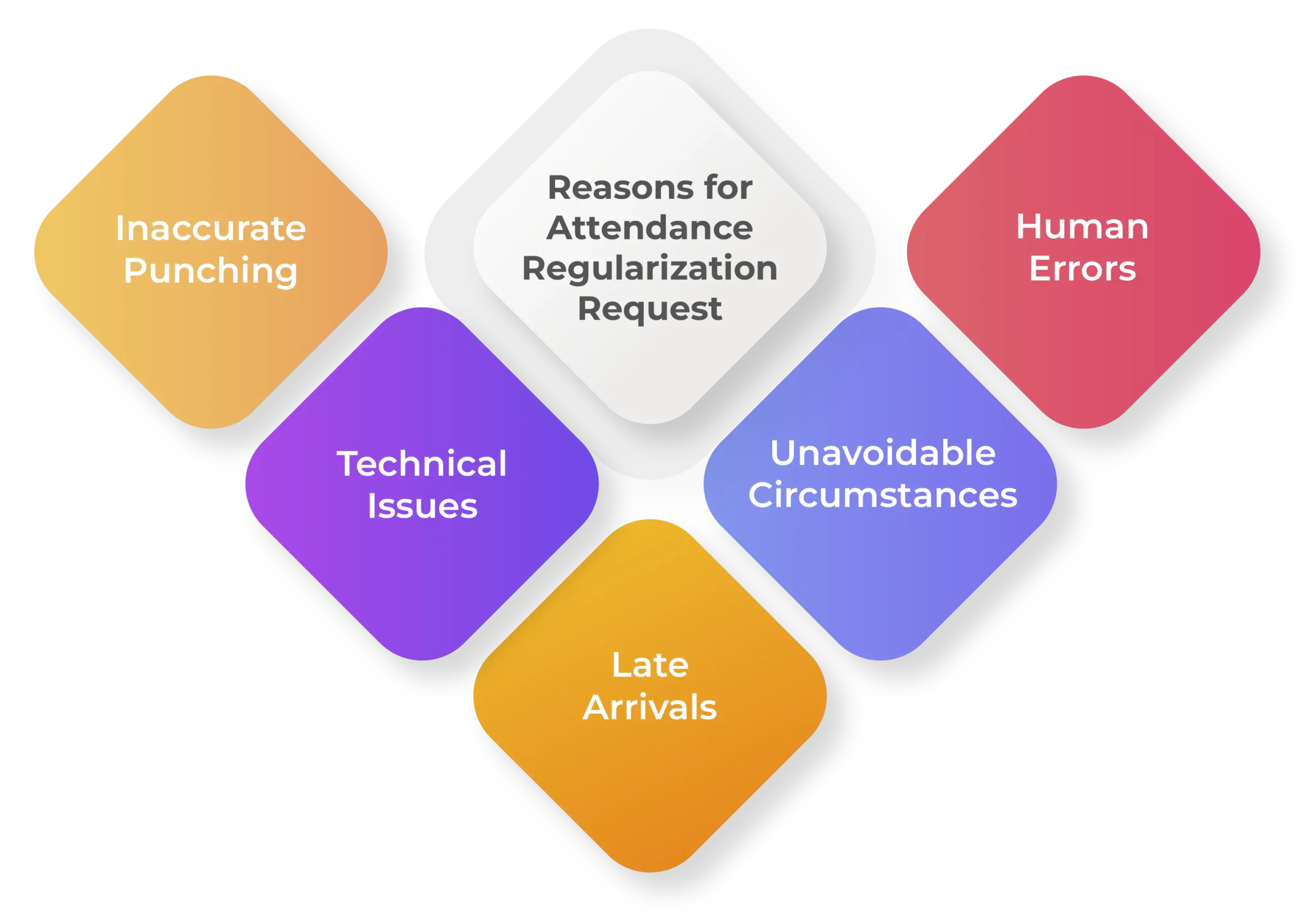What is Attendance Regularization?
Attendance regularization is the process of correcting employees’ attendance records to ensure they accurately reflect their actual working hours. It usually includes rectification of any inconsistencies, such as missed attendance marking, late arrivals, early leaving, etc. It also accommodates unique attendance scenarios such as work from home or irregular work arrangements, ensuring accurate attendance.
Attendance regularization requests are sent to managers by employees who want to modify their attendance details, via their attendance management software. The manager verifies the request based on their actual attendance for a specific working day, complying with the company’s policies. Hence, it is an essential feature for organizations, as it helps avoid false attendance data, which can occur due to missed punch in-outs, early departures, or even technical issues.
Reasons for Attendance Regularization Request
The common reasons for applying attendance regularization are:

1. Inaccurate Punching
Inaccurate attendance punch-in and out details can result in attendance regularization requests by employees to avoid loss of pay. Attendance inaccuracy may occur due to various reasons, such as missed punches, punching before the shift end time, overtime, etc. Remote and hybrid working models have increased the importance of regularizing attendance records, as there are scenarios in which employees have half-day field work, while they need to report to the office for the other half.
2. Technical Issues
Technical issues that result in attendance regularization include power outages, malfunctioning of biometric devices, inaccurate attendance capture, or glitches in attendance records. Since employees’ wages are calculated according to their working hours, any discrepancies in the data arising due to technical issues should be dealt with as soon as possible.
3. Late Arrivals
Employees may arrive late at their office due to several reasons. However, they can regularize their attendance if their company policy allows it. Official tasks such as client visits, market surveys, door-to-door marketing by sales personnel, out-of-office meetings, workshops, conferences, etc., are acceptable reasons for late arrivals, which should be regularized by their reporting managers.
4. Unavoidable Circumstances
Any deviation from the normal attendance requires regularization to avoid loss of pay. However, unavoidable circumstances such as unusual traffic congestion, train or bus cancellations, vehicle breakdowns, accidents, etc., can also lead to delays. Hence, the manager can approve these requests if they comply with the organizational policies, as it helps create a sense of belongingness in the work culture.
5. Human Errors
Employees can make mistakes and may forget to punch out after their shift. There can be days when an employee forgets to punch even after coming or leaving on time due to several reasons. In such cases, attendance regularization comes to their rescue as they can rectify their mistakes through it.
Importance of Attendance Regularization
Attendance regularization is crucial for the organization as well as the employees, as it is essential for ensuring accurate attendance records. Having precise records enables the organization to pay their employees on time, while they remain loyal to their organization for longer.
The following are some of the major benefits of attendance regularization, which make it extremely important for companies of all sizes:
- Provides flexible timings.
- Helps maintain accurate attendance.
- Boosts employee satisfaction and morale.
- Reduces payroll discrepancies.
- Decreases HR’s administrative workload.
- Improves employee trust.
Process of Attendance Regularization
Attendance regularization is a multi-step process. To ensure that it is undertaken seamlessly, you can categorize the steps into the following groups:
➔ Identify Issues in Attendance
The first step is to identify any discrepancies in your employees’ attendance. Attendance issues can arise from several reasons such as late-coming, early-leaving, overtime, time-offs, etc. However, these should accurately reflect in the attendance records as well as in the leave management system, as any error will translate to erroneous employee salaries. Hence, you should begin the process of attendance regularization by identifying any issues with employee attendance.
➔ Investigate Reasons for Discrepancies
Once the attendance issues are identified and documented, you can move on to investigating the reasons for these discrepancies. For example, HRs and managers can work together to identify whether an employee left early or whether there was a glitch in the system that simply identified their leaving early. Similarly, they should check and verify each employee’s claims against proof to ensure that all records remain accurate.
➔ Regularize Attendance Records
Now that you have accurate records of your employees’ attendance, you should start making changes to the existing records. You are required to overwrite any existing records with the corrected values to accurately reflect your employees’ actual working hours for a specific salary cycle. By correcting the attendance records, you can ensure accurate salaries, compensating your staff adequately for their time and effort.
➔ Communicate with Employees
Once the changes are implemented in the attendance records, you should also inform your staff of the changes. It ensures transparency in the organization, while employees can contact HR or their manager if there are further changes required.
➔ Record Changes Undertaken
The final step is to make records of the changes undertaken for safekeeping. It is essential to make records of these changes for future reference, as it will help the organization if any disputes arise in the future. Since you have already informed your employees of any changes made, having a record of the same discourages anyone from making false claims.
FAQs on Attendance Regularization
1. What are the reasons for the Attendance Regularization request?
There are various reasons for attendance regularization, such as:
- Forgotten punches
- Technical errors
- Absence from work
- Early-leaving
- Overtime
- Late-coming
- System downtime
- Work trips
- Working from home.
2. How long does Regularization take?
Depending on the company policies and the size and complexity of the company’s structure, attendance regularization can take anywhere from 2 days to a week to complete. Modern organizations have dedicated attendance management software in place to streamline this process, making it extremely easy for employees to apply for regularization, as well as the managers approving them.
3. When should I apply for Attendance Regularization?
You should apply for attendance regularization as soon as you notice any issues with your attendance information. Organisations usually place some kind of restrictions on the number of regularizations as well as the duration of regularization to ensure that it is not misused by the employees.
4. Is there a deadline for submitting Attendance Regularization?
Yes, companies generally impose some form of deadline for submitting attendance regularizations. It is often set to be within the current salary cycle, as submitting the request after the cycle makes it harder to compute. Hence, by enforcing a deadline for regularization, companies ensure timely approvals and accurate attendance records.
5. What happens if my Attendance Regularization is rejected?
If your attendance regularization request is rejected, you may face pay cuts or even disciplinary action, based on the terms and conditions of your employment. While companies usually do not take disciplinary actions, they can resort to them if they find that you have tried to game the system using your request.


